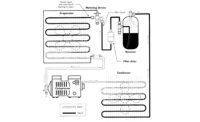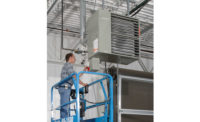He’s got plenty of reasons to smile.
- The company manufactures infrared products, which are gaining more of the commercial and industrial heating market each year.
- Last year the company had one of its products, the Suntube infrared compact heater, named product of the year by Plant Engineering magazine (The News, Aug. 31, 1998).
- The company had its R&D lab certified by International Approval Services, in conjunction with the American Gas Association and the Canadian Gas Association (The News, Aug. 24, 1998).
- Solaronics added a software program that analyzes and forecasts building fuel costs (free to users).
- And the company is working on some “fun” projects, such as designing heaters for year-round golf driving ranges. Its involvement with LAUNCH™ The New Golf Game, may prove to be one of the most lucrative and profitable ventures for
Solaronics and its distributors and contractors.
Solaronics, formed in 1962, occupies a 70,000-sq-ft facility and employs 50 workers. The company is known for its infrared heaters, but other products are also familiar to the general public.
Lester said there is an easy way to remember what his company makes, especially if you’re a fast food junkie.
“If you go to McDonald’s and order some fries, under the kettle are two Solaronics burners,” he said.
Let's do launch
The popularity of golf continues to attract record numbers of golfers to the courses and driving ranges, and Solaronics is playing a big part in keeping the game a year-round sport.A new golf game and recreational facility called LAUNCH™ was introduced in Toronto. The two-tiered, outdoor driving range, which is open all year, is heated in winter by Solaronics high-intensity heaters — 64, to be exact.
According to Solaronics’ “Case History Number 65,” LAUNCH Corp., the Canadian company based in Woodridge, Ont., and Canadian sports enthusiast John Lang introduced this new type of golf game. The game offers players of every skill level all the challenges of conventional golf.
An illuminated fairway and the heated, double-decker driving range allow golfers to approach the game the same way a bowler approaches a bowling alley. Scores are kept based on the accuracy of drives, which are identified by marked landing areas on the fairway.
LAUNCH Corp. wanted to create a facility where golfers could play year-round in a controlled atmosphere. But that wasn’t the intention of the company when it first launched LAUNCH.
“We did not expect to be open in the winter, and heating was envisioned to just take the edge off in cool weather,” said company chief financial officer John McManus.
The company took bids on the cost of installing gas and electric heating. When it looked at the cost of installing infrared heaters and the cost to operate them, LAUNCH became a year-round option.
“We were looking for functionality at a price we could afford,” added McManus. “The Solaronics gas infrared heaters met all our criteria.”
He was impressed with the heaters for three reasons: customer comfort, energy cost savings, and allowing for the extension of the season into the winter months.
On a snowy December day last year, McManus stopped to talk with a player and asked her how she enjoyed the game. “It’s so comfortable, I could spend the winter here,” he said she told him.
That didn’t surprise McManus. With individual temperature controls on each LAUNCH pad, golfers can select their own comfort levels.
McManus has plans to expand LAUNCH in Canada and is looking to enter the U.S. market, too. The company’s expansion plans bode well for Solaronics and its customers, if McManus and his management team continue to be satisfied with the results.
Infrared advantages
“A big advantage of infrared is that you can have zone control without partitions,” explained Lester. “Each zone can be controlled by one thermostat, which is cost effective.“I can come in to work on a Saturday morning and work in one section of the shop without having to heat the whole area with blowers. The only advantage to blowers is that they are cheaper to design and install, period.”
The high-intensity heaters generate 1,650° to 1,750°F heat, and are characteristically unvented (without an overhead fan). These types of heaters are found in high-ceiling buildings and generally are placed around the perimeter of a building.
Low-intensity heaters with a tubular design can range in size from 10 to 70 ft long, and generate up to 1,000°.
These heaters vent in outside air and vent out the inside air, which is especially important in a dirty work environment, where dust and dirt can clog up a high-combustion, high-intensity heater.
While it is important for a heating system to function efficiently in many different environments, Lester said lower energy costs are the bottom line for building owners and managers.



Report Abusive Comment